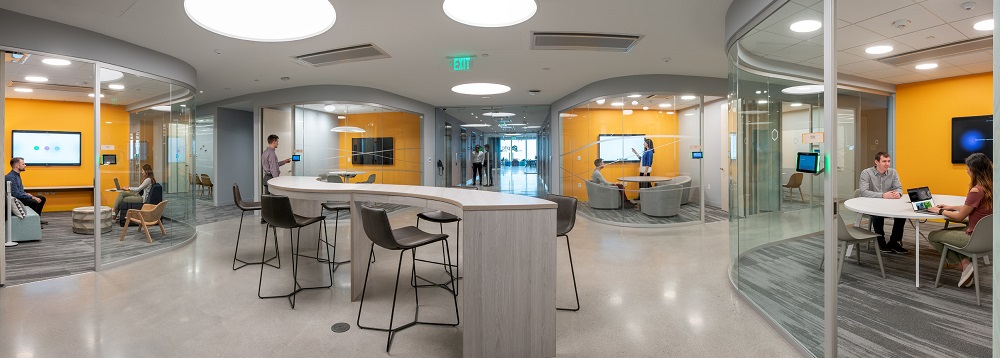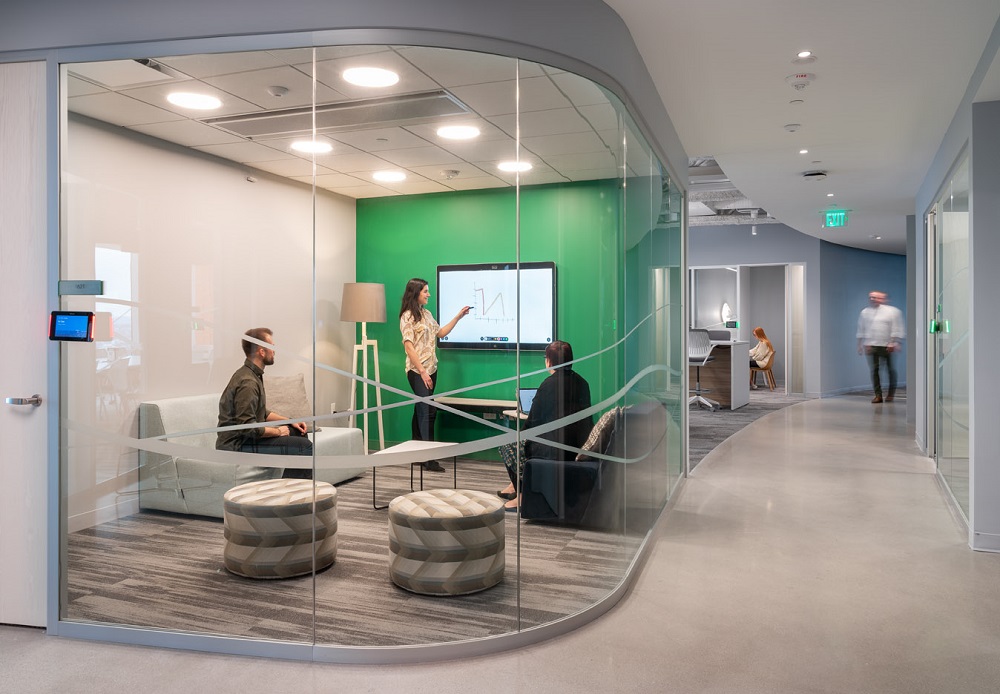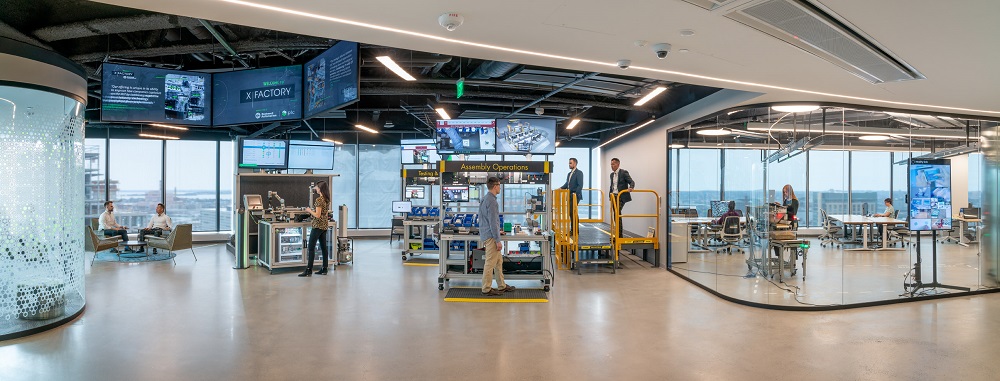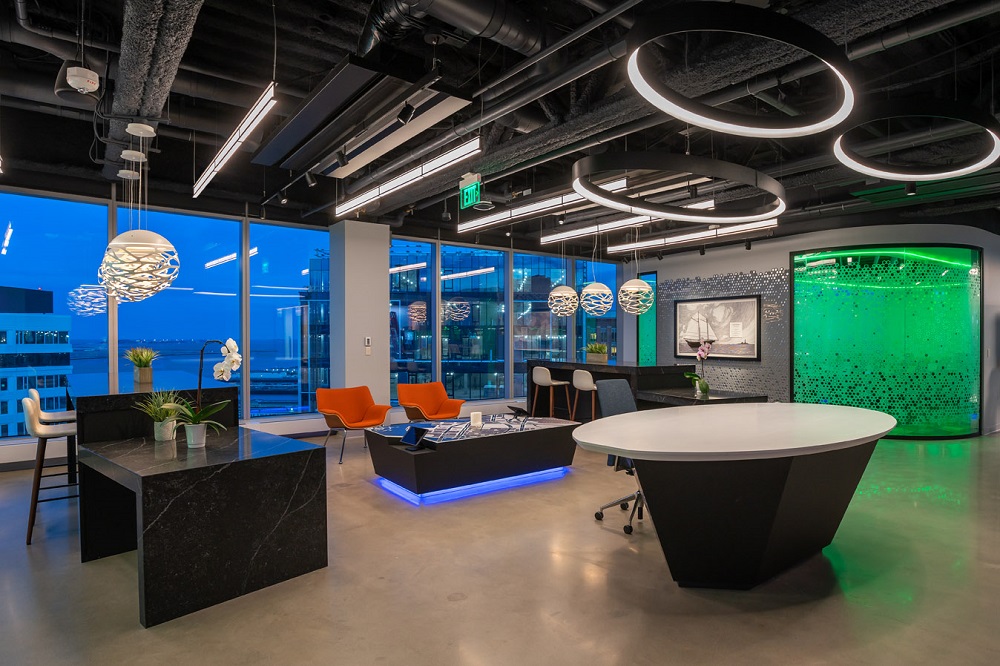It’s good to have helpful neighbors. PTC, a global business software provider long based in a Boston suburb, decided to move its corporate space to the city’s fast-growing seaport district. In order to attract young, forward-thinking professionals that will continue to help PTC stay at the forefront of technologies such as virtual reality (VR), augmented reality (AR), Internet of Things (IoT) and more, PTC knew it had to create the right work culture.
That cultural workplace transformation goes beyond moving to Boston’s coolest business neighborhood. It involved completing rethinking its work environment and embracing a more open- and task-oriented space philosophy.
As luck would have it, the AV integration firm it would work with on its new space, Red Thread, is located pretty much next door — and it went through its own work space transformation a few years ago.
Learning from the Integrator’s Own Experience
John Mitton, VP of Red Thread’s AV group and CTO, admits that when his company made the workplace transition a few years ago he didn’t exactly embrace the shift. “We went from private offices and workstations to an open-floor plan, no pre-assigned workstations,” he says. “There was a lot of push back from everyone, myself included.”
[related]Mitton is completely on board now and says he never wants to go back to a private office. Meanwhile, he believes the first-hand experience helped Red Thread be a valuable partner to PTC during its transition. “We were able to transfer that to them and help them reduce their anxiety and actually work with them quite a bit on change management.”
“We really pushed the rate of change about as far as you can go in terms of workplace strategy because we wanted to foster collaboration,” says PTC’s John Civello.
That change management was only part of the process of outfitting PTC’s new headquarters, located in a 17-story building overlooking Boston Harbor.
To make the transition work the new space had to be filled with amenities and had to be conducive to collaboration.
It was quite a cultural shift, says John Civello, VP of corporate real estate and workplace, PTC.
“We hired a consultant with workplace strategy experience. They helped us understand what other companies are doing around the country [and] the world. We knew we wanted to change dramatically from what we had in our old offices,” he says.
Those suburban Boston headquarters had about 50% offices and 50% cubes and presented employees with “complete isolation throughout the day,” Civello says. “I could spend the whole day in my office in that old building and not see anybody. We wanted to get away from that as much as possible.”
PTC employees most definitely got away from “complete isolation” at its 121 Seaport Boulevard location.
After considering a moderate approach with some open office spaces and some offices, it ultimately went with no offices at all and 100% open floor plan with zero assigned work stations, opting instead with task-based stations and work neighborhoods.
“We really pushed the rate of change about as far as you can go in terms of workplace strategy because we wanted to foster collaboration,” Civello says.
However, the shift toward open- and task-based work space is only part of the story behind PTC’s new space.
In fact, the collaboration PTC did with Red Thread and its other technology and consulting partners is most on display on the 17th floor which features several meeting spaces and a corporate experience center that provides a platform for prospective clients to walk from vignette to vignette and directly experience technologies such as AR, VR, IoT and more — with the goal of helping them to envision how these solutions can enhance their businesses.
“The PTC corporate experience center is designed to allow visitors from around the world to experience all aspects of digital & workplace transformation from the moment they arrive and continuing through their visit,” says Ari Kaufmann, corporate experience center architect, PTC.
PTC’s Need to Move and Present Content
PTC is one of Boston’s first AV over IP enterprise-wide technology implementations, according to Red Thread, adding that a Crestron DigitalMedia NVX platform provides a flexible and scalable solution that configures, deploys, and maintains audiovisual technology on the IT network.
This platform allows PTC to distribute content to any display throughout their headquarters.
Given the size and complexity of this initiative, it required months of planning and coordinating network configuration, security, and bandwidth requirements with the IT team.
More than 140 technology-enabled collaboration spaces support PTC’s activity-based workplace. There are huddle rooms of different sizes and conference rooms with different purposes.
“The coordination was intensive, more than I’ve ever dealt with in my career,” says Civello.
“I remember the days when you’d just put a projector on the table and plug it in. Now all these systems are dependent on the network, so there’s huge dependency between the AV solution and the network.”
Meanwhile, successful transition from traditional- to open-office requires planning for appropriate meeting spaces — and PTC’s technology team did that. In the end, more than 140 technology-enabled collaboration spaces support PTC’s activity-based workplace.
There are huddle rooms of different sizes and conference rooms with different purposes, any of which may require both PTC employees and clients to walk in and expect to be able to present and collaborate easily.
“We created a very consistent environment that makes it really easy for customers to come in and plug in,” says Tim Donovan, conferencing and audio-visual supervisor, PTC.
Over 126 Cisco collaboration room systems make remote calls and content sharing easy. To maintain a consistent user experience, those spaces with Crestron touchpanels were customized to emulate the Cisco control interfaces.
The installation of 141 Steelcase RoomWizards and Workplace Advisor software allows PTC’s employees to reserve spaces in advance or ad hoc by referencing the Live Map visual on each floor and RoomWizard displays outside each meeting space to view real-time occupancy. The sensor data helps PTC understand usage trends.
Read Next: How to Combine Corporate Culture with AV Technology and Sales
There’s also a town hall style feel to the café area, dubbed “The Common,” which is also on the 17th floor.
It’s designed not just for meals and breaks, but to create a community space for large gatherings and presentations.
“It was important for us to build a space that could not only serve as an area large enough for a lot of the company to come to but for us to broadcast to the world – to have them see and hear us and vice versa,” says Donovan.
It boasts two 3×2 video walls to offer a dramatic backdrop for an immersive visual experience.
AV Meets AR, VR and IoT
As impressive as the meeting room solutions are, it’s the integration of AR, VR, IoT, product lifecycle management, 3D and CAD technologies that make it truly unique. As an innovative software provider, PTC sought to challenge its customers to help them envision applications that serve their goals. In the corporate experience center, the 20 experiential exhibits rely on AV to do so.
The Corporate Experience center offers a customized, hands-on tour powered by PTC’s industrial IoT, AR, product lifecycle management, 3D CAD technologies and more.
As a software provider that prides itself on providing customers with access to technologies like AR, VR, IoT, 3D printing, etc., PTC wanted a space that would allow people to open their minds and visualize how they can use these platforms for their brands.
The Corporate Experience center offers a customized, hands-on tour powered by PTC’s industrial IoT, AR, product lifecycle management, 3D CAD technologies and more.
“It’s designed to allow visitors from around the world to experience all aspects of digital transformation,” Kaufmann says.
From the moment those visitors arrive, they’re greeted with augmented reality experiences, “one of which highlights the Seaport Innovation District here in Boston,” he explains. “It’s a history lesson that shows the four industrial revolutions that’s overlaid on a model of the ship that was discovered when they excavated this building. In fact, the model itself is made out of the wood of that ship.”
From that point visitors move from station to station.
“We literally put our customers on pedestals to highlight how PTC solutions have enabled their successes,” Kaufmann says.
“We tell stories through a combination of self-service pods where guests can play videos on their own and learn about the value that their customers have realized by partnering with us, and augmented reality experiences where we show instructions that can be delivered in a human-focused manner with handheld, wearable and hands-free technologies.”
In order to create these interactive spaces, PTC worked with Path Audio Visual to blend these solutions into a Crestron touchscreen experience. CEO Mike Russo says Crestron is at the heart of many of the Corporate Experience Center exhibits.
“It was a very custom interface that I created using different aspects of PTC’s website and logo color scheme,” he says.
“The controls we included on the main technician’s touch panel are system power timers that turn on and off the entire space, video/audio routing, volume control for each of the 15 zones, password access, and interactive sound effects.”
“I actually think AV integrators are well-positioned to leverage IoT if we have the guts to go after it,” says Red Thread’s John Mitton.
Red Thread’s Mitton, like many in the AV integration industry, had been hearing and reading about how technologies like AV, VR and IoT will play a role in their applications.
This dialog, however, has been mostly conceptual. That changed with the PTC project.
“The implementation at PTC really opened my eyes [and] the entire team’s eyes about the capabilities or the opportunities there in front of us with augmented reality, virtual reality, IoT and 3D printing,” he says.
Mitton sees applications — both for Red Thread customers and for its own processes — within many of these technologies. When it comes to IoT, for instance, “I actually think AV integrators are well-positioned to leverage IoT if we have the guts to go after it.”
AV integration firms need to look forward and recognize a unique opportunity, according to Mitton. “No one does what we do, which is take all these disparate technologies and put them together to work seamlessly,” he says. “It is out of our comfort zone but something we’re working towards.”
If Red Thread’s PTC project is any indication, it’s on the right track.













